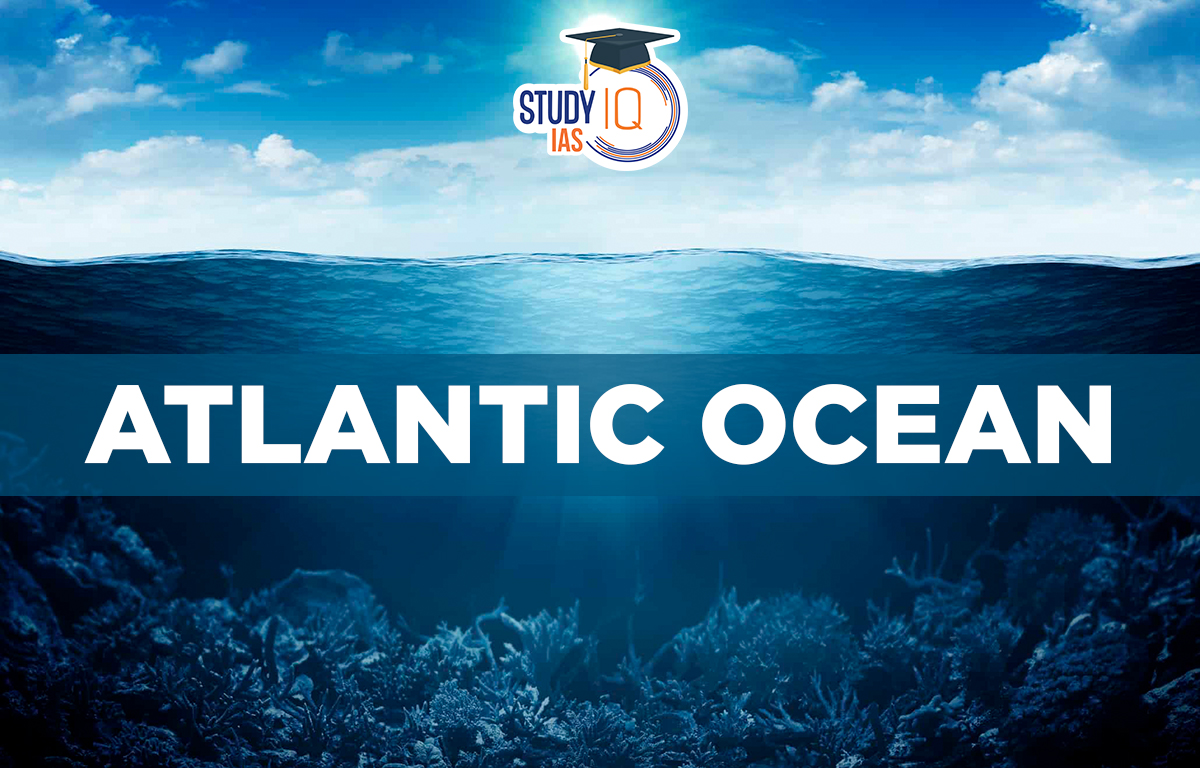Table of Contents
Atlantic Ocean
The Atlantic Ocean is a body of salt water that covers roughly one-fifth of the Earth’s surface and separates the continents of Europe and Africa to the east and North and South America to the west. The ocean’s name is derived from Greek mythology and means “Sea of Atlas.” It is second only to the Pacific Ocean in size.
The Atlantic Ocean is the second-largest ocean, covering about 106,460,000 square kilometers. It is located between North and South America to the west and Europe and Africa to the east. The ocean formed as North and South America drifted westward due to plate tectonics. Its shape is S-like, and it has an average depth of 3646 meters. The currents in the Atlantic Ocean affect the climate in Northwestern Europe and Africa. These currents are driven by the Earth’s rotation, wind, sunlight, and water density. This article provides helpful information about Atlantic Ocean currents for IAS 2024 candidates to help in their preparation.
| Atlantic Ocean | |
| Size | Second largest Ocean in the world |
| Location | Body of water between Africa, Europe, the Arctic Ocean, the Americas, and the Southern Ocean |
| Area | 85.133 million sq km |
| Coastline Length | 111,866 km |
| Ocean Volume | 23.3% of the world |
Read about: Indian Ocean Dipole
Atlantic Ocean Countries
Seas that make up the Atlantic Ocean and their bordering Countries are given below in the table:
| Name of Sea | Bordering Countries |
| Argentine Sea | Argentina, Uruguay, Antarctica |
| Baltic Sea | Sweden, Denmark, Germany, Poland, Lithuania, Latvia, Estonia, Russia, Finland |
| Black Sea | Bulgaria, Romania, Ukraine, Russia, Georgia, Turkey |
| Gulf of Mexico | US, Mexico, Cuba |
| Greenland Sea | Greenland, Iceland, Svalbard (Norway) |
| Caribbean Sea | Cuba, Jamaica, Dominican Rep, Puerto Rico, Costa Rica, Nicaragua, Guatemala, Honduras Belize, Venezuela, Columbia, Panama |
| Hudson Bay | Quebec, Ontario, Manitoba, and Nunavut provinces of Canada |
| Irminger Sea | Iceland, Greenland, Canada |
| James Bay | Quebec and Ontario provinces of Canada |
| Labrador Sea | Labrador peninsula of Canada, Greenland |
Atlantic Ocean Deepest Point
The Milwaukee Depth is the deepest point in the Atlantic Ocean, located about 100 miles (160 km) northwest of Puerto Rico. It reaches a depth of 8380 m and is part of the Puerto Rico Trench, situated between the North Antillean Arc and the Puerto Rico Ridge.
Atlantic Ocean Water Circulation
- The Atlantic Ocean is shaped by prevailing winds and nearby land.
- Ocean currents circulate water in the Atlantic Ocean.
- It is the second-largest ocean, covering about one-fifth of Earth’s surface.
- Atlantic currents significantly affect the climates of North-Western Europe and North-Western Africa.
- These currents also support rich fishing grounds in the Grand Banks off Newfoundland, Canada.
Read More: Ocean Waves
Atlantic Ocean Currents
Ocean currents are the steady flow of water in a certain direction. Several things influence these currents:
- Heating by the Sun: When the sun warms the water, it expands.
- Wind: Wind blowing over the ocean surface helps push the water.
- Gravity: Gravity pulls water in, causing differences in pressure.
- Coriolis Effect: In the Southern Hemisphere, water moves to the left, while in the Northern Hemisphere, it moves to the right.
All these factors affect the ocean currents in the Atlantic Ocean.
Read More: Ocean Tides
Equatorial Atlantic Ocean Currents
The Easterly Trade Winds in the area push two currents from east to west. These are called the North Equatorial Current and the South Equatorial Current, and they start near the west coast of Africa. Between these two currents, there is an eastward-flowing current called the Equatorial Counter-Current. All three of these currents are warm because they are close to the equator. Here are the three currents in the equatorial region:
1. North Equatorial Current
Normally, this equatorial current forms between the equator and 10° N latitude. This current is created when cold water rises up off the west coast of Africa. It flows from east to west but changes direction to the north when it reaches the mid-Atlantic Ridge near 15°N latitude, and then it turns south. Along the east coast of Brazil, the land splits the current into two parts: the Antilles Current and the Caribbean Current.
2. South Atlantic Equatorial Current
This warm current moves from the west coast of Africa to the east coast of South America, between the equator and 20° S latitude. When it reaches Brazil’s east coast, it splits into two parts: one goes north to join the north equatorial current near Trinidad, and the other goes south along South America’s east coast.
3. Counter-Equatorial Current
The counter-equatorial current flows westward between the strong equatorial currents to the north and south. The eastward drift, known as the Guinea Stream, is stronger. It has a higher temperature and lower density than the other two equatorial currents.
Read More: Ocean Currents
North Atlantic Ocean Currents
The trade winds in the North Atlantic play an important role in maintaining consistent east-west currents. The following are the major ocean currents in the Northern Hemisphere’s Atlantic Ocean:
1. Gulf Stream
The Gulf Stream is a system of several currents that originates in the Mexican Gulf around 20° N latitude. It continues north-eastward along the eastern coast of North America until it reaches the western coasts of Europe around 70° N latitude. The current system consists of the following components:
- The Florida Current flows from the Florida Strait to Cape Hatteras.
- The Gulf Stream begins at Cape Hatteras and travels to Grand Bank.
- The North Atlantic Drift moves from Grand Bank to the Western European coast.
2. Canaries Current
This current brings cold water from the polar regions. It continues from the North Atlantic Drift and flows south along the Canary Islands’ coast after turning near Spain. It cools the warm Western African coast between Madeira and Cape Verde, moving at an average speed of 8 to 30 nautical miles per day.
3. Labrador Current
The Labrador Current is a cold current that flows along the coasts of Newfoundland and the Grand Banks, coming from Baffin Bay and Davis Strait near Greenland. It carries large icebergs, making navigation tricky. Near Newfoundland, it meets the warm Gulf Stream around 50°W longitude, creating dense fog.
Read More: Ocean Deposits
South Atlantic Ocean Currents
The South Atlantic Ocean flows in a pattern similar to the North Atlantic Ocean, but in the opposite direction. The Southern Hemisphere is home to four major ocean currents. These are discussed further below:
1. Falkland Current
The Falkland Current carries cold water from the Antarctic Sea. It flows from the south to the north along the east coast of South America, reaching Argentina. It is strongest around 30°S latitude and can bring icebergs from Antarctica to the South American coast.
2. Brazilian Current
This warm current forms when the South Equatorial Current splits at Cape Sao Roque in Northeast Brazil. It flows south along the east coast of South America to about 40°S latitude. Then, the Westerlies and the Earth’s rotation push it eastward. Here, it meets the cold Falkland Current coming from the south.
3. South Atlantic Drift
The South Atlantic Drift, also called the Westerlies Drift, continues the Brazil Current eastward. The Westerlies push the Brazil Current to the east as it moves south, which is why it’s called the Westerlies Drift. This cold current is also known as the Antarctic Drift.
4. Benguela Current
When the South Atlantic Drift splits at the southern tip of Africa, one branch flows down the west coast of South Africa. This branch is called the cold Benguela Current. It eventually joins with the South Equatorial Current, completing the ocean current circuit.
Atlantic Ocean UPSC
The ten major Atlantic Ocean currents have been discussed in this article. Their origin, the factors that influence their movements, and the paths they take have all been identified. In addition to this topic, it is critical to study the Pacific and Indian Ocean currents to gain a comprehensive understanding of how they operate and the impact they have on climate systems.


 Desert Climate, Distribution, Climatic C...
Desert Climate, Distribution, Climatic C...
 Deserts of India Map, Features of Thar D...
Deserts of India Map, Features of Thar D...
 Indus Valley Civilization, History, Phas...
Indus Valley Civilization, History, Phas...





















